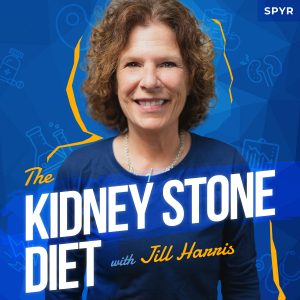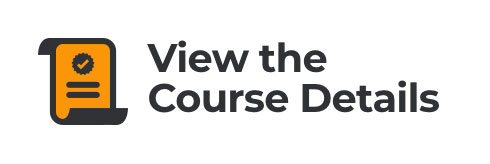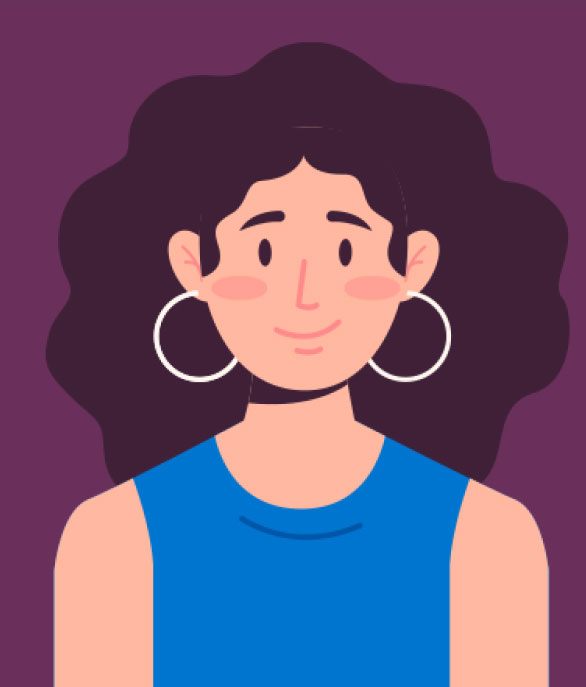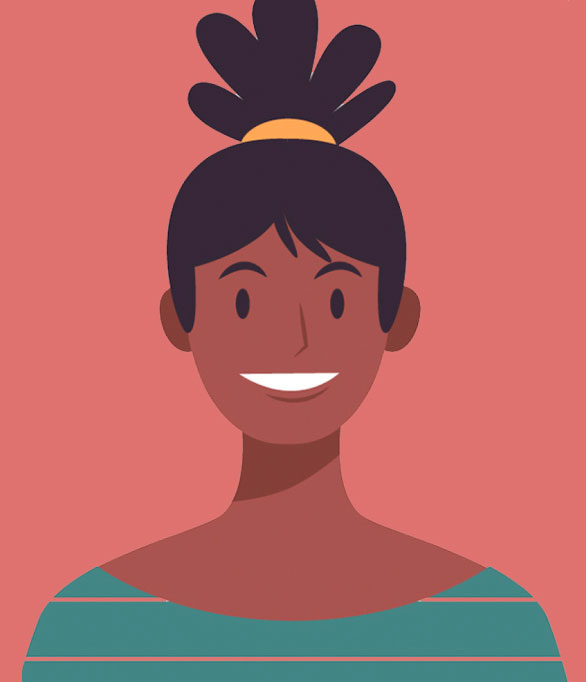This week, Jill breaks down the worst foods for kidney stones and kidney stone prevention.
Jeff Sarris: Welcome back to the Kidney Stone Diet podcast, the show about reducing your kidney stone risk and living your best life. I’m your host and fellow student, Jeff Sarris. And I’m here by myself today with–
Jill Harris: Kidney stone prevention nurse, Jill Harris. Oh my goodness, Jeff. I just–the light just went out for just one second. It just went out. So, today we’re going to talk about–I said it was the kidney stone’s worst food. That’s what we’re going to label this: the worst foods for kidney stones. And another way to say it, too, is the highest oxalate foods it could be both.
Jeff Sarris: Yeah, what do you want to avoid?
Jill Harris: Yeah, what you want to avoid when you want to lessen your kidney stone risk. Here’s what I want to say though: I want you guys–please, can you please subscribe to the channel? I’m so desperate. I will do anything because what I want is more kidney stone formers to get reputable, reputable information from a YouTube channel. And that would be us. What we’re trying to give you here is the best information to prevent kidney stones. All of this is based upon Dr. Coe, Fred Coe, his work from University of Chicago. He’s been doing this for over 50 years and it’s all based in science, even though I sound like street urchin. This stuff is drenched in science from from his website over there.
Jeff Sarris: Well, and you’re a nurse. You’ve been doing this for over 22-23 years. So, yeah, there’s a lot of credentials here that, unfortunately, are lacking in a lot of other spaces.
Jill Harris: Yes, yes. So we want people to find us quickly. If you Google “kidney stones,” we don’t show up and I want us to show up! So, subscribe, please. Also, I’m giving a raffle. I’m going to pick two winners from all of you who subscribe, but you have to tell me. So, email me at [email protected]. Let me know you subscribed. So I’ll say in that email. And then when we get 5000–we’re at 4500 now around– when we get up to 5000 subscribers, I’m going to pick two winners of the raffle and give you–I will contact you through email and give away two consults. One each, one each. That’s worth $225, thank you very much.
Jeff Sarris: Yeah, because it just means a lot. Subscribing, hitting that bell, or telling your friends–anyone who you know who is suffering through kidney stones, or has had them in the past and doesn’t want to form them again, which is anyone who’s had kidney stones, we just want to help as many people as we can. So that’s the whole goal with everything we’re doing here.
A lot of times we have call-ins, so if you have a question, the number is 773-789-8763. And we’ll feature your question on a future episode. But we wanted to do some of these more FAQ really nitty gritty, specific aspects of reducing your kidney stone risks. So, today, we’re going to go into the worst foods for kidney stones.
Jill Harris: Yes, or otherwise known as, “What are the highest oxalate foods and things you should avoid in the Kidney Stone Diet.” Number one, the worst foods for kidney stones is not following the Kidney Stone Diet. There’s that. So you want to decrease your sugar, and your salt. You know, you want to follow the goals of the Kidney Stone Diet, but the highest oxalate foods that people tend to overeat and can lead to kidney stones are found on kidneystonediet.com start page, but I’m going to also read it so you can hear what I’m saying here.
What are the Highest Oxalate Foods?
So, we all know that the number one worst food you can eat for kidney stones is spinach, unfortunately. It pains me to take away healthy foods and the problem with the low oxalate diet is when you have a kidney stone and you are at the doctor’s office, he or she will say, “Stop eating fruits and vegetables. Lower your oxalate.” And so you Google “oxalate,” you see that there’s so much misguided information or, you know, lists that say one thing, one list says another thing so who do you believe? We deal with the Harvard list. That’s who we promote. We’ve been using it for decades. Our patients use it along with the other advice that we give. Our patients reduce their urine oxalate. The end.
Unless they have malabsorption issues, 95% of my patients will never have to worry about oxalate again once they understand the oxalate list, and how to use it. Here are the highest oxalate foods, or foods you should avoid. The worst foods for calcium oxalate stones. Number one is spinach. Rhubarb is really up there, too, 541 milligrams per cup. Spinach is 755 milligrams per cup. So it’s very high. And for most of you, we want you to have a goal of 100 milligrams of oxalate a day. Some of you may be told the even go less than that if you’ve had a bariatric surgery, or you have malabsorption issues. So it’s 100 milligrams a day unless your doctor has told you otherwise.
Rice bran–look at your ingredient list people lots of things are have rice bran in it. Very high at 281 milligrams a cup. Buckwheat groats, what the hell are those? I don’t know. They’re buckwheat and they’re groats. They’re in things. Lool for it. Look in your ingredient list. There’s buckwheat flour, there’s all kinds of stuff with buckwheat groats. And 133 milligrams a cup. That’s a lot. Almonds, 122 milligrams. That’s a lot! And so many of you come here–one of the worst foods for kidney stones, almonds, because why? Because if you have ttwo almonds, you’re gonna get a kidney stone? No, but you were eating almonds like this all day long because the dietician or your dialysis nurse told you to eat almonds as snacks and you took that advice, extrapolated it out, and it became a whole new meaning of “eat almonds.” And so you’re eating them all day long. Keto people who eat almond flour, almond milk, almonds, too much. The worst food for kidney stones, okay? So, take them away.
Jeff Sarris: Looking at the list there, too, that’s only one ounce. One ounce of almonds is not very much. It says 22 kernels and that’s not a lot of almonds. I mean, it’s a handful at most.
Jill Harris: That’s right. And so what do I hear all day? “Jill, I was eating handfuls of almonds!” Yeah, hundreds and hundreds. That’s the problem. It’s not because you had two almonds. It’s overeating them. Miso soup, 111 milligrams, that’s a lot. And also miso soup is super high in sodium, so that’s not a good food. Wheat berries another one, 98 milligrams of oxalate, really high. And, so, corn grits, baked potatoes with skins, soy beans, so we get lower and lower. Cocoa powder, or hot chocolate–this is why chocolate is to be watched–brown rice flour. Brown rice flour is used in a lot of things.
Turn it around, Buster Brown, and look at your ingredient list, and you’ll see. Millet, cornmeal, very high. Shredded Wheat, the cereal, french fries–”Jill, I can never have a french fry again?” So spinach and almonds, just take away. Of course, buckwheat groats, you should not be eating either, but once we get down to things that are less than 100 milligrams of oxalate, here’s where it gets tricky. So you’re gonna see on my website at kidneystonediet.com, on the “Start Page” there is a download, a beautiful handout called, “The High Oxalate Foods to Avoid.”
I’m sure Jeff will put it in there in the description, so you can pluck that out. Now, although this is a nice handy list of things that you should avoid, I want to teach you something that I teach my private patients and I teach my students in the Kidney Stone Prevention Course, especially when they have a hankie and they’re wiping away the tear and they’re like, “What the hell? I can never have a french fry.” Because french fries are 51 milligrams of oxalate, in whatever serving Jeff, does its say what serving it is?
Jeff Sarris: Oh, yeah, let me go back there and look.
Jill Harris: Go ahead, look. French fries. So, Jeff will look that up–but they’re high. And whenever you form kidney stones, you’ll feel that one of the things they’ll take away is french fries. Now, is it practical to think that you’re going to live every day for the rest of your life and not have a french fry? If somebody told me I could never have a crinkle fry again, I would get a shovel, dig a hole, and jump in. And that’s it. And I’d ask Jeff to put the dirt on top of me and that would be the end of me. There’d be no point in having a breath. So, here’s the deal: french fries, they’re not a healthy food anyway. Does that mean you can’t have them? A hundred percent no. It doesn’t mean you can’t have them. Of course you can have french fries. Did you find a serving on that, Jeff?
Jeff Sarris: Yeah, so for French fries, it says four ounces, or half a cup.
Jill Harris: Okay, so half a cup. Ain’t nobody eatin’ french fries, half a cup. That’s four of them, a very small amount. So, when we have fries, we typically have some fries. Now, for those of you who are eating fries over and over every single day with lunch and dinner, of course, it’s going to add up real quickly. Have some fries. Have them once a week, drink some milk with them, if you want, or whatever. You don’t have to–you know, and if you don’t have milk, it doesn’t mean you can’t have the fries, but make sure you get your calcium needs that day met. Try to do that.
It would be ideal if you could have some milk with it because the milk, the calcium or even a non-dairy source of calcium will bind with the oxalate that you’re eating right then, and it won’t be absorbed as much into your gut. It will leave through the stool, but it has to have some calcium to join with the oxalate in your intestine. So, some of these things when we get under, you know, 90 milligrams of oxalate, of course, you can even have your Shredded Wheat once in a while. You could even have raspberries once in a while. I think they’re 48 milligrams for like a cup or half–I don’t know if it’s a cup or half a cup. Look at your list of the high oxalate foods to avoid, but they’re also higher.
When we eat things like raspberries, they’re healthy. So we tend to eat a bushel. So even if you want to put a few raspberries in your Greek yogurt, of course. And then along with that, put some blackberries and blueberries because those are low–or strawberries. That’s a low oxalate fruit. Sometimes, we just want to see a little bip of a food that is a no-no. Just a little bip. It’s always going to be about portion. No matter what we’re trying to do here in the diet world. When we eat too much, we gain weight. When we eat too much of high oxalate foods, we have a higher risk of forming kidney stones.
So we want to limit our risk of kidney stones. So we want to limit the high oxalate foods. It doesn’t mean you can never have them. It means that if french fry is your favorite food, and you want to designate one day a week of having some, you’re not going to form a stone for that. It’s what we do over and over without having any calcium in our day. That’s what forms a kidney stone. And all the other parts of the Kidney Stone Diet: hydration, salt–which by the way, french fries are salty, obviously. You know, added sugar, all of those things.
But when we’re specifically talking about the worst foods, they tend to be the higher sugar, higher salt foods, but also the higher oxalate foods. So get that list, download it, you’ll see beets is on there. And many kidney stone patients will say, “Well, I guess I can never have my beets again.” But you really can if you have a smaller portion, split the beet salad with your partner, and have a with calcium, and have it once a month instead of every day. Is that making sense, Jeff?
Jeff Sarris: Oh, yeah, it absolutely does. And just to reiterate, everything you’ve seen on the screen is read on the website. So, kidneystonediet.com/oxalate-list. If you just go to the “Start” page, you can find it from there: kidneystonediet.com/start. But yeah, I’ll have the link in the description as well. And you’re able to sort by the milligrams per serving. And, obviously, we have the servings listed there, too, and some of the servings might be smaller than you may anticipate. Just like with almonds, and when they come down to just an ounce or half a cup of something like spinach, a half of a cup of spinach is nothing. It cooks down to absolutely nothing.
So then, a cup of spinach then is raw and then cooks down. And yeah, so it’s just stuff to think about that we’re trying to make it as simple as possible for you, because this is a lot of info. Just to say 700 milligrams, 56 milligrams, a half a cup of this, a quarter cup, like, there’s so much so we have this here to try to help in the, hopefully, the most friendly way possible, where you can just go type in your word to search and hopefully it’s on the list. But, again, we’ve done an episode on this. Not every food is going to be listed there because as Jill mentioned, this is the Harvard list. This was done a while ago and not such a long time ago that that’s an issue by any means, but sort of new “superfoods” in quotes aren’t going to be found on there. Like, what are some of the things that people do ask about, generally?
My Philosophy on Superfoods
Jill Harris: Oh, all kinds of things. Goji berries or whatever the hell they are. Spirulina, you know, whatever new things are out there. Oh, the collagen all the time and there is research that says collagen is high. It converts over to oxalate. So yeah, listen, it really annoys me the whole superfood thing and we need to do a video on that, too. Superfoods and kidney stones, or super foods and healthy eating in general, all produce is a superfood. Eat it all within normal portion size, except spinach for stone formers. It’s just marketing junk. So if you’re going to eat a pear, it’s just a super as if you’re going to eat, you know, a raspberry, except don’t eat so many. Now, look, you know, grapes, are they a superfood? They have some little things, but they’re also a lot of sugar in there.
I hate the word “superfood” because what does that mean? People are going to overeat that food. And then that superfood, five months later, winds up in the in the Home Goods or Marshalls reduced section because everyone’s sick of hearing about it and now there’s a new superfood! That’s how this goes, people. It’s marketing junk. And I do want to reiterate, what I’m looking at is the high oxalate foods to avoid handout on the “Start” Page of Kidney Stone Diet.
So what Jeff’s talking about is the search engine where you can search for foods that’s also on the “Start” page, and then I’m talking about the handout: the “High Oxalate Foods to Avoid” handout. You could just put that right on your fridge, if you’d like. So, you can print it out and do that. So the point is, too, we don’t even know what the hell we’re talking about most of the time, because there’s so many free tools at kidneystonediet.com “Start” page that you can–I mean, I don’t know how much of our free time we spend making free things.
Jeff Sarris: Oh, yeah, there’s just so much. And I just have it up on the screen right now the “Start Here” page. And you can find the food lists and just everything else. There’s a “Resources” section, which I don’t even have up right now. But yeah, the different products and the goals, the grocery list. Here’s the oxalate list down below here that you can easily just click to download, enter your email address, I think, and then you’re ready to go.
Jill Harris: Yeah, awesome. Love it!
Jeff Sarris: Oh yeah, no email address. Actually, I’m going to rewind that because you don’t have to enter anything, whatsoever. I will just go back to that screen there just so people can see. But, yeah, you just go to the printable oxalate list, go to download, and then it’s right there. And it’s printable. No, we’re not asking for anything at all. But it is funny, because we’ve done so many things on there that it is hard to remember at times, because everything, all of this info is forever valid. Like this is all drenched in science, as you’ll say. And it’s not like it’s changing.
So we made this list based on the Harvard–this graphic based on the Harvard list–but it’s been out there for a little bit, so I haven’t even thought about “Okay, how did we set it up for people to download?” But yeah, everything is right there on the “Start” page, which acts also as the “Resources” where you can find the “How to Better Interact with your Doctor at your Doctor’s Visit,” and all sorts of different flyers and resources, a printable grocery list, Kidney Stone Diet goals. But yeah, we have so many things on there, and that’s just kidneystonediet dot.com/start, where you can find all that.
Jill Harris: Yes, use it. Use the resources. I can’t tell you how many people ask me the same questions. You know, “Jill, why do you keep talking about that “Start” page?” Because, people, you’ve got to go to it. So here I am, I am a vessel use me up. Here Jeff is, use us up! But, also, you’ve got to do the work. “That’s kind of crabby, Jill.” It’s the truth. And we all know I’m here to spread the truth. So the diet won’t work if you don’t. So what we are here is to show you to try to explain things to you as best we can in 15 minutes. But also to tell you, “Look, we are producing free tools for you to use.” All the social media that is being done, we are trying to foster this message: kidney stones can be prevented.
Don’t let anyone tell you you’re a stone maker. Now there’s a few bips of you that may be stone makers, but I promise you this, we can at least lessen your stones. That’s a promise, if not eradicate them altogether. So we’re here to do the work and give you the knowledge and to guide you where you need to go. Get yourself some help. And, also, if you want to get there faster, then you use my paid resources. My paid services: the Kidney Stone Prevention Course, the 15-minute urine analysis call where I’ll help you understand your urine report so you can have an excellent doctor office visit instead of going to the doctor office visit and it wasn’t a great visit because you don’t know what you don’t know, and also private consults, if you like. So, everything on that website is going to help you get where you need to go. The end. The end.
Jeff Sarris: Yeah, so we want to thank you for listening and if you’re not already subscribed, we’d love it if you hit that subscribe button, and that little bell, and tell your friends. Tell anyone who needs to know about the show and know about the Kidney Stone Diet and just know how to reduce their risk. I mean, they don’t even need to come to the show. They can go to the website kidneystonediet.com/start. So many free various resources, the weekly email newsletter, just everything. And like Jill mentioned, there is premium content as well.
So, if you wanted a deep dive into the course, if you wanted to have the group calls that are involved in the course, hugely valuable to spend time with others going through the same thing you are. I think that’s a great spot to wrap and if you have any questions specifically that you want answered on the show, the phone number is 773-789-8763, and we will feature your question on a future episode. Yeah, thanks again for listening and we will see you next time.
Jill Harris: Thanks for being here. Bye!














Leave a Reply